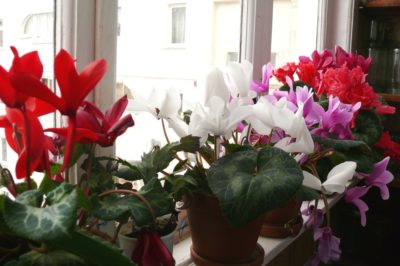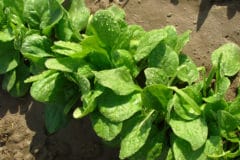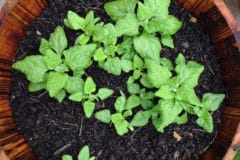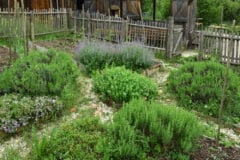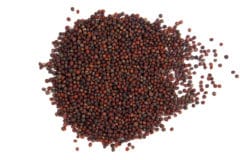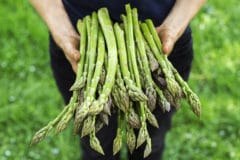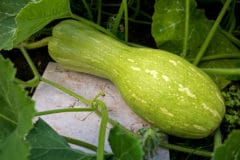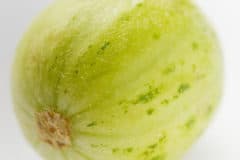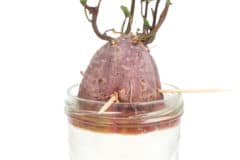How Does Cyclamen’s Mediterranean Origin Affect Its Growing Cycle?
Cyclamen’s growth cycle can be confusing. You may think that you have killed the cyclamen you bought in January when it stops blooming and the leaves start turning yellow just as you think its time to start planting. The truth is that your cyclamen is probably just entering the dormant phase of its growing cycle.
Most species of cyclamen originated in the eastern Mediterranean where winters are mild but summers are more harsh with high temperatures and very little rain or moisture in the air. For this reason, these species of cyclamen, and other plants from the same area, grow and bloom during the cool but moist winter and go dormant during the summer.
Two species of cyclamen, Cyclamen colchicum and Cyclamen purpurascens, originated in the cooler mountain regions of the Mediterranean. These two species do not go dormant during the summer. Instead they retain their leaves from the previous year until after the leaves have developed for the next year.
Cyclamen purpurascens also blooms in the summer and autumn, as does Cyclamen hederifolium. Cyclamen coum and Cyclamen persicum bloom in the winter, as you might expect, while Cyclamen repandum flowers in the spring.
What Is the Difference Between a Tuber and a Corm?
While some refer to the cyclamen’s bulb-like feature as a corm, it’s actually a tuber, like the tubers of begonias and potatoes.
A corm, such as the corms formed by crocuses, has a thin, papery covering as onion bulbs and garlic cloves do. Corms also have a basal plate, like the growing tip on a bulb, from which the roots emerge.
Roots may sprout from any location on a tuber – sides, top, or bottom – just as they would on a potato, but the leaf and flower stems sprout from the top of the tuber.
Where the roots sprout from a cyclamen tuber depends on the species. While thick, anchoring roots emerge from the bottom of Cyclamen graecum tubers, Cyclamen hederifolium tubers produce roots from the top and sides. Like Cyclamen graecum, Cyclamen coum and Cyclamen persicum roots emerge from the bottom of the tuber.
What Are the Differences Among the Different Species of Cyclamen?
Except for the Stargazer variety of Cyclamen hederifolium, the five-petaled cyclamen flowers point downward. On some cyclamen, like Cyclamen hederifolium, the edges of the petals curl into auricles while on others, like
Cyclamen persicum, the edges of the petals are smooth. The flowers are red, purple, pink, or white. Most species offer a choice of pink or white flowers, but a few bloom only in white. The flowers may be marked with a darker color on the nose, and these markings also vary by species.
While the underside of the leaves are usually shiny and colored a solid red, purple, or green, the upper sides display variegated patterns of silver or shades of green. The variegations vary even within plants of the same species and may be irregular or may form a striking Christmas tree or arrowhead shape.
Leaf shapes range from the heart-shaped leaves of Cyclamen persicum to the round leaves of Cyclamen coum to the ivy-shaped leaves of Cyclamen repandum and Cyclamen hederifolium. The edges of the leaves may be finely toothed, like the leaves of Cyclamen graecum or smooth like the leaves of Cyclamen coum subsp. coum.
The most important difference among the species of cyclamen may be their varying degrees of frost hardiness. Frost-hardy species include:
- C. hederifolium: Has survived prolonged freezes and temperatures as low as -22°F (-30°C), hardiness zone 5a
- C. cicilium: Tolerates temperatures as low as -4°F (-20°C), hardiness zone 6b
- C. coum: Tolerates temperatures as low as -4°F (-20°C), hardiness zone 6b
- C. purpurasens: Tolerates temperatures as low as -4°F (-20°C), hardiness zone 6b
- C. repandum: Tolerates temperatures as low as 7°F (-14°C) but not prolonged freezes, hardiness zone 7b
- C. graecum: Tolerates frosts at temperatures as low as 25°F (-4°C) for only a few hours. hardiness zone 9b
Depending upon your hardiness zone, the varieties above are the ones that you can select for growing outdoors.
C. africanum, C. rohlfsianum, and C. persicum, the florist’s cyclamen, tolerate only brief, mild exposures to frost. For that reason, C. persicum is usually sold as a houseplant.
Whether indoors or outdoors, C. persicum grows best at temperatures between 68°F (20°C) and 59°F to 43.7°F (15°C to 6.5°C). If temperatures warm to above 68°F (20°C), the plant, like most species of cyclamen, can take it as a signal that the hot Mediterranean summer is coming, and it may begin preparing to go dormant.
How Do I Plant Cyclamen?
Cyclamen can be grown from seed or from tubers, and the tubers can be divided to create additional plants. Which method you should use depends on whether you are growing Cyclamen persicum; the indoor, florist’s cyclamen; or the frost-hardy, outdoor species.
Although it can take 15 months to produce mature flowering plants from seeds, Cyclamen persicum usually is grown only from seed. The hardier species of cyclamen can be grown from either seed or tubers.
Where Should I Plant Cyclamen Outdoors?
Cyclamen grow best in cool, well-drained, shaded areas with indirect sunlight. They prefer loose loamy or sandy soil, but they can be grown in clay soil if the soil is loosened with mulch or compost. In fact, whether your soil is clay or loam, working two to three inches of compost, mulch, or some other organic material into the bed where you intend to plant your cyclamen is a good idea.
If you live in one of the cooler hardiness zones; such as 5, 6, or 7; you can help your cyclamen out by looking for microclimates in your yard that are more protected from frosts and freezing, such as spaces that are sheltered by a building, a wall, or a row of shrubs.
What Kind of Container Should I Use for Planting Cyclamen Tubers?
The container should be large enough to leave about an inch of space between the tuber and the pot. Containers for cyclamen should allow for good drainage. For that reason, African violet pots work well.
You can satisfy the need for drainage and humidity by sitting your containers of cyclamen on a layer of pebbles, gravel or some other material in a water-filled trays. Your cyclamen planter should not be sitting with the bottom of the container immersed in water because cyclamen tubers are susceptible to rotting if they become too wet.
What Kind of Container Should I Use for Planting Cyclamen Seeds?
You can plant cyclamen seeds in 3-inch or 4-inch pots. Plant about 20 seeds per container.
What Type of Potting Mixture Should I Use for Cyclamen?
The potting mixture that you use should hold water but drain well. You can plant container grown cyclamen in a sandy or loam-based potting soil with some peat moss or grit added. Violet potting soil also works well.
Cyclamens also do well in soilless potting mixes, but you will want your cyclamens to be able to soak up plenty of water when they emerge from their dormant state in order to encourage the growth of flower and leaf stems. Soilless mixes don’t hold water as well as a loam-based potting soil will.
How Do I Grow Cyclamen From Tubers?
You can grow cyclamen from tubers in the ground or in pots indoors or on a balcony or patio. Just make sure that the pot is large enough to accommodate the tuber and allow it some room to grow.
When Should I Plant Cyclamen From Tubers?
While you can plant cyclamen tubers while the plants are growing, it’s easiest to plant them when they are dormant. You won’t have to deal with the roots and the flower and leaf stems. Cyclamen also can be a bit fussy about being disturbed, so your planting, plant division, and repotting is more likely to be successful if done while the plant is dormant.
If you want to divide a Cyclamen persicum tuber, grow the plant from a tuber, or repot a Cyclamen persicum tuber, you should wait until the leaves have turned yellow and died off and the plant has gone dormant. This will happen in the spring, usually in April.
Tubers for the hardier garden species of cyclamen should be planted, divided, or repotted in the fall.
How Do I Divide Tubers?
Tubers are divided in the same way that you would divide a seed potato. Remove the tubers from your pots or dig them out of the ground, and brush the soil off of the tubers. Use a sharp, clean knife to cut the tuber into pieces, making sure that each piece has at least one growing nodule. The growing nodules are the rough bumps on the top of the tuber from which the flower and leaf stems emerge.
How Do I Plant Cyclamen Tubers?
If you are planting a whole tuber and not one that is divided, you first need to determine which is the top of the tuber and which is the bottom.
Cyclamen coum comes close to having a sphere-shaped tuber while the tubers of Cyclamen hederifolium is slightly flattened. The tubers of older plants from the cyclamen species of rohlfsianum and purpurascens may become misshapen by shoulders of plant tissue that separate the tuber’s growing points.
Regardless of these differences, though, when examining the tubers, you will find that the bottom will be smooth and rounded while the top will have growing nodules that make it feel and look bumpy and rough.
Whether you are planting the tuber in the garden or in a container, you should position it with the bumpy growing nodules pointing up and the smooth, bottom side down against the soil or the potting medium.
If you are growing your cyclamen in pots, you should cover most of the tuber with at least a half inch of grit, leaving just the top of the crown above the soil line.
Outdoors in the garden, cover the tubers with at least 1/2 inch of soil.
If you are covering cyclamen tubers from the purpurascens, repandum, and hederifolium species with mulch or loose compost, you can plant them as much as 6 inches deep. If you live in hardiness zones 5 or 6, you may want to plant your tubers that deep to better protect them from frosts and freezes.
How Do I Space Tubers?
How you space your tubers depends on the size of the tuber and whether you are placing them in their permanent bed or container or whether you plan on moving them.
If you are planning on moving the plants after they sprout, you might want to plant them a little farther apart to create space to dig them up.
If you are planting your tubers in their permanent location, you can plant smaller tubers, like tubers from the species Cyclamen coum, and tubers that you have divided as close as 6 inches apart. Larger tubers, such as those of Cyclamen hederifolium should be spaced at least 1 foot apart.
Water your tubers after planting them and keep the soil or potting mixture moist to encourage the growth of roots, leaves, and flowers. Don’t allow the soil to become wet, though, because, as mentioned previously, tubers are susceptible to rotting, especially those that have just been divided.
How Do I Grow Cyclamen From Seeds?
It is easier to grow cyclamen from tubers than from seeds, and growing cyclamen from tubers produces mature, flowering plants more quickly. Although the seeds of most species do sprout within four to ten weeks of planting, it may be a year or more before the plants bloom. In addition, Cyclamen purpurascens and others may take a year to sprout. However, seed is the preferred method for growing Cyclamen persicum.
If you are growing your cyclamen from seeds, you can sow them directly in the ground, or you can start them indoors in containers and transplant them later.
When Do I Sow Cyclamen Seeds Outdoors?
When you should sow your seeds outdoors depends on your hardiness zone.
If you want to sow your seeds directly in the ground and you live in zone 5 or 6, you can try starting your seeds in the late summer or early fall and covering them with a cold frame or a grow tunnel to protect them from the harsher winter weather. You can also watch for more sheltered microclimates on your property and try planting your cyclamen in those areas. Otherwise, you should wait until spring to sow your seeds.
If you grow your cyclamen in a cold frame, let them remain there for two years before you move them to where you want to grow them permanently.
If you live in a zone with milder winters, you can sow your seeds in late summer or early fall.
If you sow your seeds in the fall, keep in mind that they are likely to germinate slowly, and they may only produce a single leaf before winter arrives.
When Do I Start Cyclamen Seeds Indoors?
You can start cyclamen seeds indoors at any time. Starting your seeds indoors gives you a greater chance of success with getting seeds to germinate and produce plants. Seeds that have been started indoors also produce mature, flowering plants more quickly than seeds started outdoors.
How Do I Start Cyclamen Seeds Outdoors?
Before planting, you should add a drop or two of dishwashing liquid to a cup of warm water and soak your cyclamen seeds in this mixture for 24 hours. Cyclamen seeds need darkness to germinate, so space your seeds 1 inch apart and then cover your seeds with at least 1/2-inch of soil or grit. Keep the soil moist, but do not allow it to become overly wet.
How Do I Start Cyclamen Seeds Indoors?
To start your cyclamen seeds indoors:
- Begin by soaking your seeds for 24 hours in warm water with two drops of dishwashing liquid added, as described above.
- Select a container with a sufficient number of drainage holes that is at least 2 inches deep.
- Fill the container with a mixture of commercial seed starter and bone meal.
- Thoroughly moisten the starter mix with water.
- Press your cyclamen seeds lightly into the starter mix, spacing them 1inch apart.
- Cover your seeds with 1/4 inch of perlite, medium to fine grit, or clean sand. This layer will provide darkness and keep your seeds in place.
- Keep the starter mix moist, but allow the cover layer of sand, grit, or perlite to dry out between each watering.
You can find the grit at feed stores where it’s sold as poultry grit and classified as turkey grit, layer grit for laying hens, grower grit for young poultry, and chick grit for chicks. You’ll want the finer grower or chick grit for covering your cyclamen seeds.
Keep your containers of cyclamen cool and moist, and place them in a space where the temperature remains between 50°F and 65°F (10°C and 18°C). When started in this way, Cyclamen hederifolium and Cyclamen coum should germinate in six to 10 weeks.
You can set your seedlings outdoors in a cool, shaded space in the summer, and if you keep them moist, they may continue to grow without entering their dormant state. If they do begin to go dormant, reduce your watering, but don’t allow your containers to become completely dry.
Resume watering your dormant seedlings in September to encourage them to emerge from dormancy and resume growing.
For the winter, move your seedlings indoors under grow lights, to a cold frame or grow tunnel, or to a greenhouse. A high percentage of your seedlings will mature into blooming plants in half the time needed by seeds planted directly into the ground. You can begin transplanting your seedlings to their permanent beds or containers from May through August.
Most of your cyclamen will begin blooming in their third year. As your plants enter dormancy, you can harvest the seeds for starting new plants. Harvest the seeds when the pods begin to soften under your touch. Cyclamen seeds remain viable for several years.
How Do I Care for Cyclamen Planted Outdoors?
Hardy outdoor cyclamen need very little care. During the growing season – fall, winter, and spring – cyclamen usually receives a sufficient supply of water from nature. The plants don’t need fertilizer, but you can add bone meal to the soil.
During the summer, provide some water to keep the roots from dying off and cover the area where your dormant cyclamens are planted with a layer of compost or mulch to conserve moisture, discourage weeds, and add some nutrients to the soil.
You will need to begin watering in late summer through early fall to encourage your cyclamen to emerge from dormancy and resume growing, but again, when the autumn rains arrive, they should begin supplying enough moisture to sustain growth.
If the area where you have your cyclamen planted collects an over abundance of fall leaves, brush them aside so that your cyclamen receive sufficient light. Don’t rake them, though because you could damage the crown of the tuber. If a freeze should occur, you can protect your cyclamen by covering them with evergreen branches or a light covering of leaves, but remove these as soon as the weather allows.
What Outdoor Pests and Diseases Can Attack Cyclamen?
In general, cyclamen is rarely attacked by diseases or pests. Aphids may show up, but because of the reversed growing season, cyclamen is usually dying down as aphids emerge. Boll weevil larva can eat into the tubers and cause them to rot, but beneficial nematodes can be released in the spring and fall to control the larva.
If you are trying to collect the seeds, you may have to compete with mice and squirrels who want to eat them. Burrowing moles and gophers and squirrels burying nuts may root some tubers, but overall, you shouldn’t be faced with a lot of problems.
How Do I Care for Cyclamen Grown as a Houseplant?
Cyclamen persicum is the species of cyclamen most frequently grown as a houseplant. It doesn’t demand a lot of care, but it is fussy about its growing conditions. It prefers to have temperatures between 68°F and 43.7°F (20°C to 6.5°C). Warmer temperatures cause it to go into dormancy.
Exposure to too much heat from direct sunlight through a window or a furnace register also can cause your cyclamen to go dormant. They do need indirect sunlight, though, so north or east facing windows are usually good locations for them.
Cyclamen persicum is one of the least cold resistant cyclamen species. Keep these plants out of cool drafts and, if you have them growing on a window sill, move them into the interior of he room on cold nights.
Overwatering can cause the tuber to rot, and getting water on the leaf or flower stems can cause the stems to rot. So when you are watering, water below the leaves and be careful to get the water into the potting mixture and not on the plant. Keep the soil moist but not wet, and wait until the potting mix feels dry to your touch before watering again.
Over fertilizing cyclamen interferes with blooming. Only apply a water soluble fertilizer every two months, and dilute it to half the recommended strength.
When you notice that your cyclamen has stopped blooming and the leaves are starting to turn yellow and drop off, stop watering it and allow the leaves to die. You can remove the dead leaves and flowers, and then move your cyclamen to a cool, dimly lit space for two months as it sits dormant. Don’t allow the potting mix to dry out completely, as that will make it difficult to get it to retain water when your cyclamen is ready to emerge from dormancy.
After two to three months, bring the cyclamen back out of storage. It might already have resumed growing. Check to see if the tuber seems crowded in the container. If the tuber is outgrowing the container, than repot your cyclamen.
Soak the potting mix thoroughly, and then allow the excess water to drain off. Keep your cyclamen moist and well-watered but not overly wet until you see normal growth returning. Then, resume taking normal care of your cyclamen until it is again ready to enter its dormant state.
What Pests or Diseases Attack Cyclamen When It’s Grown as a Houseplant?
When cyclamen is grown indoors, it doesn’t have any diseases. It can attract spider mites and soil gnats, however.
Spider mites are tiny, but they leave their webs all over cyclamen leaves, so you might notice that your cyclamen’s leaves look dirty or faded before you see the culprits behind that look. Spider mites are attracted to dry conditions, so increase the humidity levels around your cyclamen by wiping the leaves gently with a damp cloth and sitting your containers in a tray filled with pebbles and water, as mentioned previously.
Soil gnats, on the other hand, are attracted to moisture. If you see them flying around your cyclamen, wait to let the potting mix dry out a little longer between each watering.
